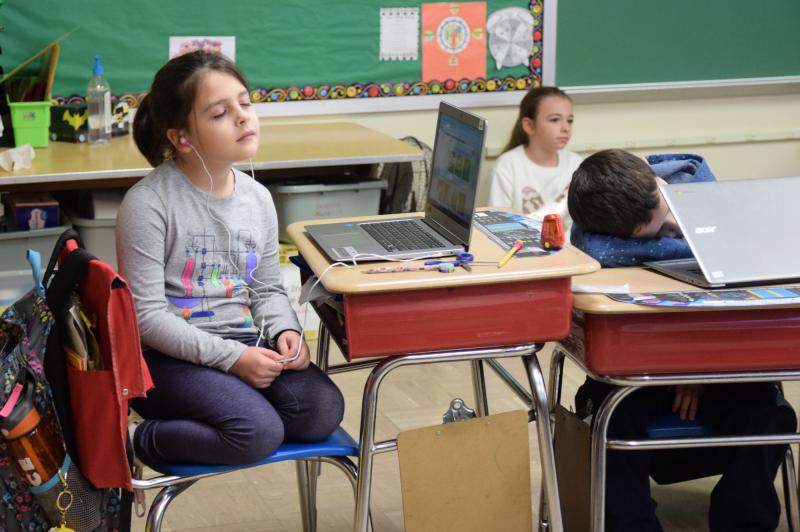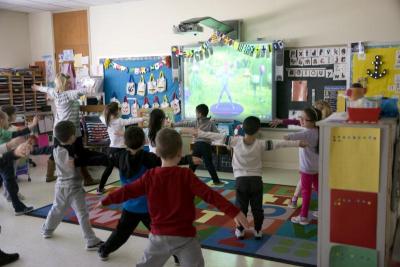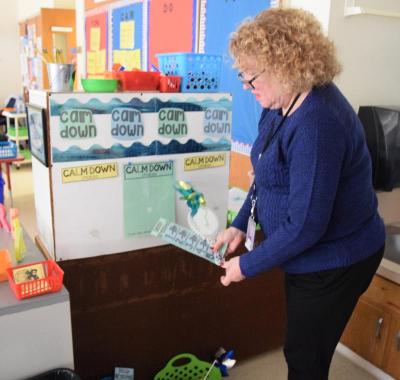Boosting mindfulness with yoga, ‘brain breaks’ at Potter Elementary School
Early into the school day on January 4, Cathy Claassen’s fifth grade class put down their books and broke out the yoga mats. Claassen dimmed the lights, and led her group of students through warrior poses and deep breathing exercises. Ten mind-clearing minutes later, it was back to the books.
Scenes like this play out frequently at Potter Elementary School, where staff and administrators are leading an effort to bring “mindfulness” into each and every classroom.
“There’s lots of ways to calm our minds and bodies down to engage in listening and learning,” explained Principal Heidi Brooks.
A new focus on supporting students’ social and emotional development began about three years ago, and has only intensified since then. It’s a major goal of both the school and the district as a whole. Each year, Potter administrators have added new tools and techniques to help teachers and students be more mindful.
This year, teachers are using a new tool called Mind Yeti to provide calming and mindful exercises during the school day. The program provides online audio-based videos which leads students through calming exercises. On Friday, a second grade class incorporated a Mind Yeti program designed to build students’ empathy by walking them through helping a fellow classmate having a bad day.
“They younger the child the more emotionally dysregulated they can be,” Brooks noted. “That’s what we’re trying to get our elementary age kids to do: Express their needs, and figure out if it’s something we can meet, at that time, during this specific activity.”
Another new addition is special “calming areas” in each classroom. The spaces include a carpet, calming and mindfulness techniques either written or visual, and, depending on the age group, different tools like stress balls. Students can access these spaces, no questions asked, at any time during the school day.
“They all come to school in the morning and you just don’t know if they’ve had a rough morning at home, if their animal is sick, if they fought with their sibling,” Brooks said. “You don’t know this, and at some point during the day those kinds of thoughts creep into their mind and they can’t focus on what you’re asking them to focus on.”
Mindfulness programming extends far beyond simply helping students regulate their emotions: It’s also helping students learn more efficiently. Potter teachers give their students “brain breaks” throughout the day.
“It’s giving your brain a break from whatever task you were involved with,” explained school social worker Carrie Gregore. “If they were sitting for a long time listening to instruction, [teachers] can call for a brain break or movement break just to switch their brains.”
Brooks noted adults have the flexibility to take a break from a complex task, while students in school do not. Teachers have choices like GoNoodle video platform, or simple deep breathing or relocation exercises.
In a kindergarten class, students got up and moved, danced, and followed along to a story through Cosmic Kids. The YouTube videos incorporate both storytelling and yoga, making it ideal to teach youngsters who might not have the attention span for full yoga workouts to develop the basics.
“It’s great for those rainy indoor recesses,” Brooks noted as students danced and jumped around during the program.
Brooks, working with Gregoire and upper grade social worker Paul Chouinard, already have big plans for next year. Brooks hopes to install special yoga pads on the school’s new playground to provide students with a safe space to practice mindfulness at recess.
















